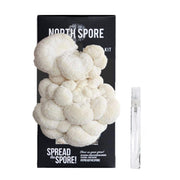Lion's Mane ‘Spray and Grow’ Mushroom Growing Kit
Our Lion's Mane mushroom kits are reliable producers and tend to yield large flushes of beautiful creamy white mushrooms when given adequate humidity. With continued proper care, you may be able to get multiple flushes. (We 100% guarantee your first flush of mushrooms, but hope you'll try for 2 or 3!)
Note: Lion's mane can be prone to drying out if the ambient humidity is too low, so we recommend that you water it generously.
Sustainability:
All of our kits are made from a blend of locally sourced, all-natural, organic, and non-GMO ingredients from farms in New England and North America.
Your kit includes an amended sawdust block fully colonized with mushroom mycelium. It may appear covered with a soft, white, mold-like substance - that's the mushroom mycelium! It is completely normal. The mycelium of some species is more prominent than others.
Cooking:
Due to its consistency and flavor, Lion's Mane can be used as a seafood substitute in recipes. We like to slice it into rounds and pan-fry it in olive oil or butter, or try ripping it up and making 'Lion's Mane Cakes' by following a crab cake recipe with the Lion's Mane subbing in for the crab meat.
Properties:
A study in Japan, on men aged 50-80 years old with mild cognitive impairment, suggests that Lion's Mane is effective at improving cognition. Subjects were split into two groups and half were given dry powdered Lion's Mane three times a day and observed over 16 weeks. At weeks 8, 12, and 16, the group taking Lion's Mane scored significantly better on a cognitive test than the other half in the placebo group (Mori et al., 2008).
Directions:
1) Inside this box is an amended sawdust block that has been completely colonized by mushroom mycelium. Open the front of your kit along the perforated line and dispose of the remaining cardboard.
2) Slice an 'X' into the plastic underneath with a sharp knife or scissors.
3) Fill the sprayer included in your kit with tap water and spritz the plastic where you sliced your 'X' shape. Spritz your kit at least twice daily - more if you're in a particularly dry climate. (If your mushrooms start to grow but dry up and die, your growing conditions may be too dry and you should make a humidity tent! See instructions below).
4) Place your kit in the most humid part of your home and outside of direct sunlight. We suggest putting it on a kitchen counter close to a sink. The mushroom mycelium will sense the oxygen in the air and produce mushroom 'pins,' another term for 'baby mushrooms.' This will usually begin to happen within two weeks of slicing the plastic.
5) Harvest before the caps flatten out and become concave. Mushrooms grow quickly, so when you spot your first pins keep an eye on them. The warmer the environment the faster they will grow. Mushrooms should be ready to harvest 2-5 days after pin formation.
How to make a humidity tent:
Simply take a trash bag or other loosely fitting plastic bag and put PLENTY of 1/2 inch holes in it (THIS IS IMPORTANT: Mushrooms exhale CO2 and inhale oxygen. They will suffocate themselves if there isn’t adequate airflow! Lion's Mane that look stringy or strange are usually growing that way because they need more air!). Spray the slice at least once per day with the included spray bottle. If you choose to use a humidity tent make sure to spray the inside of the tent once per day to maintain humidity.
IMPORTANT: Cautions and Considerations
If you’re going to consume home-grown mushrooms, make sure to cook your fresh mushrooms thoroughly with heat. If it is your first time eating this species, it is best to start with a small amount to check for allergies, even if cooked.
Mushrooms grow spores as they develop. This is a natural means of reproduction. This is when people with allergies or compromised immune systems may want to consider putting fruiting mushroom kits outdoors or in a well-ventilated area. Spores in mushrooms sometimes cause respiratory irritation. In rare cases, spores may also cause irritation for some non-allergic or non-immunocompromised mushroom growers. If you are one of them, it is recommended to reduce the overall spore load by harvesting mushrooms while they are still in their younger growth stages.

















